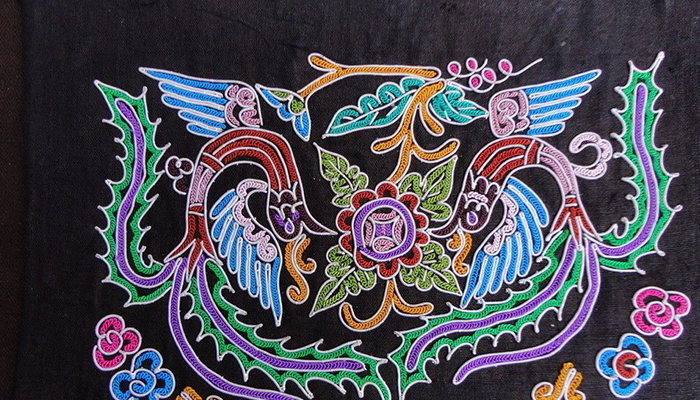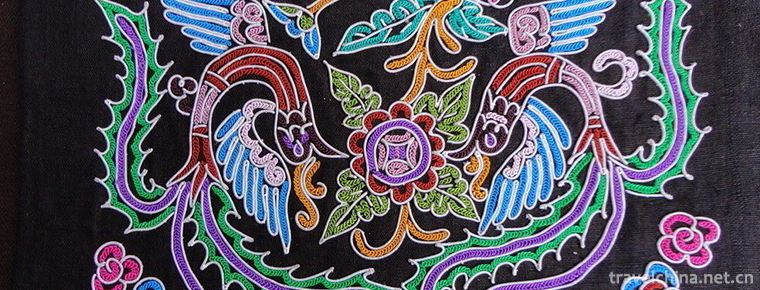Aquatic horsetail embroidery
Aquatic horsetail embroidery
Horsetail embroidery of Shui nationality is one of the national intangible cultural heritages of traditional fine arts in Sandu Shui Autonomous County, Guizhou Province.
Horsetail embroidery is a special embroidery technique inherited from generation to generation by Chinese aquarium women, which is the oldest and most national characteristic. It takes horse tail as an important raw material. Making process of horsetail embroidery is cumbersome and complex. The finished product is antique, exquisite and durable. Embroidery pattern is simple, elegant, abstract and has a fixed frame and pattern. Horsetail embroidery of Shui nationality has been handed down in Sandu Autonomous County for thousands of years, and has the reputation of embroidery "living fossil".
In May 2006, the horsetail embroidery declared by Sandu Shui Autonomous County of Guizhou Province was approved by the State Council of the People's Republic of China and listed in the first batch of national intangible cultural heritage list. The heritage number is_-23.
historical origin
There is no record of the origin of the horsetail embroidery of the Shui nationality, but it is a skill that has been handed down for thousands of years. It is the crystallization of the wisdom of the ancestors of the Shui nationality. We can only see it from the festival customs of the Shui nationality. Traditionally, the Duanjie (equivalent to the Spring Festival of the Han nationality) has the custom of horse racing. It seems that horse racing has a long history. In this long history, aquarium women invented the art of making embroidery with horsetail. Maybe the main reason is that the aquarium has the custom of raising horses and horse-tail embroidery came into being.
With the change of times, the art of horsetail embroidery is also changing. The main tone of the two straps has changed. Before liberation, the main tone of the straps was yellow. Relating to the nobility of yellow in feudal society, the main color of the back belt after liberation is red, which is the same as the concept of red as luck today.
Cultural characteristics
Characteristics of embroidery methods
This embroidery method with silk thread wrapped in horsetail has two obvious advantages. One is that the horsetail is hard in texture and can not easily deform the pattern. The other is that the horsetail is not easy to corrupt and deteriorate, and the aquatic horsetail embroidery is durable. In addition, horsetail may contain oil components, which is beneficial to maintain the luster of peripheral silk.
Major product forms
The main products are horsetail embroidered "evil knot" straps, horsetail embroidered straps and horsetail embroidered shoes.
The "evil knot" strap of horsetail embroidery
Horsetail embroidery "evil knot" strap is recognized as one of the best straps in the aquarium area, often through 52 processes to complete, the aquarium people often regard whether to have a horse tail embroidery strap as a sign of dignity and wealth. Horsetail embroidery strap mainly consists of three parts, the upper part is the main pattern, consisting of more than 20 pieces of different sizes of horse tail embroidery pieces. The surrounding frame is flat embroidered with bright red or dark green silk thread on the color satin base, while the upper two sides are horse tail embroidery straps, and the lower half is the back strap tail. There are exquisite horse tail embroidery patterns that correspond to the main part. The "evil knot" becomes the whole body. Complete artwork of embroidery. It takes about a year to make such a knot. The middle-aged and old women of Shui nationality usually do not need paper-cut bottom pattern to make "evil ending" tail flower, but embroider directly on red or blue satin with prefabricated horsetail embroidery thread tray. They use knot embroidery, flat needle and random needle synthetically. They are flexible and comfortable, and the pattern is beautiful and durable.
Horsetail embroidered back strap
"Horsetail embroidery" is actually a gorgeous embroidered "T" shaped "curtain", with tapes on both sides of the upper end, "curtain" size can accommodate young children. Its prominent feature is that it does not need paper-cut patterns to make background, but only depends on experience. First of all, two or three horsetail composite stocks are wrapped with white silk thread thinner than horsetail hair (which is split into silk) to form "horsetail thread". Then, according to their imagination, the embroiderer uses color "horsetail line" to set various geometric patterns and flower, grass, bird and sparrow pattern skeleton on the backpack (the patterns are mainly elastic horn flower, water wagon pattern, pepper pattern, echo pattern and twill pattern). The pattern, square pattern and fishbone pattern are fixed with needle and white thread. Finally, the pattern skeleton is filled with knot embroidery and spiral embroidery, which is called "patch flower" and then is embellished with shining "golden thread", thus forming a beautiful picture with complete structure, vivid image, distinct color, meticulous and delicate, luxurious and noble. The contrast of black, red, yellow and white forms a distinct visual effect. Baby straps are not only beautiful and generous, but also strong and durable. They are the best dowry prepared by mothers for their daughters. A ponytail embroidered dress often takes a woman several years or even more than ten years, so it is also the standard to measure the foundation of a girl's female honour.
Horsetail embroidered shoes
"Horsetail embroidery" embroidery shoe is a kind of tipped cloth shoe, the tips of which are pointed upward. The production method is to embroider the upper with colored silk thread to form a bottom color pattern.
Then the horsetail embroidery method is adopted, the horsetail is wrapped with silk thread, curled into various geometric patterns and mounted on the upper, then the edge is inlaid and patched. Its craft is very complex, but the embroidered pattern is three-dimensional, exquisite and chic, which can be called exquisite handicraft. Therefore, aquarium women often wear it on solemn occasions or when they visit relatives. It is very elegant and luxurious to wear blue cloth jacket, pleated skirt and silver bra with soybean milk printing and dyeing.
Inheritance and Protection
Inheritance value
The horsetail embroidery of Shui nationality has a long history and simple needling method, which is called "living fossil in embroidery". Horsetail embroidery's unique material and technology make its works full and clear, showing a unique relief texture, luxurious and stable color matching, smooth lines, full and mysterious patterns impact people's visual senses, showing a unique charm.
Heritage figures
Wei Taohua, female, Shui Minority, born in 1964, is the first national intangible cultural heritage project inheritor of aquarium horsetail embroidery.
Song Narcissus, female, Shui Nationality, born in 1966, is the first national intangible cultural heritage project inheritor of Shui Nationality Horsetail Embroidery.
protective measures
In 2008, Sandu County set up a leading group for the development of Mawei embroidery, formulated the Five-Year Development Plan for the Training of Aquatic Mawei Embroidery Folk Artists in Sandu Aquatic Autonomous County, led by the County Personnel, Labor and Social Security Bureau, and jointly participated by the County Poverty Alleviation Office, Minzong Bureau, Economic and Trade Bureau, Tourism Bureau, Wen Guang Bureau and Wen Lian, which clearly defined "further protection, development and promotion of Aquatic horses". Tail embroidery technology, comprehensively improve the production level and marketing ability of horse-tail embroidery, cultivate and bring up a group of excellent folk artists of horse-tail embroidery production, "the guiding ideology, reflects the local government's emphasis on traditional local handicraft.
From 2007 to 2011, Sandu County holds horse-tail embroidery training courses every year, including the popular "rural aquarium women horse-tail embroidery technology training courses", "horse-tail embroidery local talent training courses", as well as the improved "skilled craftsmen horse-tail embroidery advanced training courses" for skilled artists.
social influence
Important Exhibitions
From October 31 to November 4, 2018, the aquarium horsetail embroidery as a non-heritage project outside Guangdong Province participated in the Guangdong Non-heritage Week and Foshan Autumn Tour in Dawan District of Guangdong, Hong Kong, Macao and the Pan-Pearl River Delta.
On March 12, 2019, China Textile Non-material Cultural Heritage Exhibition with the theme of "Weaving Words and Embroidery Words" appeared at China International Family Textiles and Accessories (Spring and Summer) Exposition. This exhibition shows Miao batik technology, batik product production and marketing, Buyi traditional weaving technology, aquarium horsetail embroidery technology, horsetail embroidery how to integrate into daily life.


-
1.Sliced beef and ox organs in chili sauce
Sliced beef and ox organs in chili sauce is a famous dish in Chengdu, Sichuan
Time 2018-10-13 -
2.Mountain Yuntai
Yuntai Mountain is a world geological park, national AAAAA-class tourist attraction and national scenic spot, located at the junction of Xiuwu County in Jiaozuo City, Henan Province
Time 2018-10-29 -
3.Pork stomach stewed chicken
Belly chicken is a very traditional dish in Hakka area. It has a long history. It was first eaten by Hakka women when they were sitting on the moon, and it had a very good nourishing effect.
Time 2018-11-02 -
4.Jiuquwan Hot Spring ResortTime 2018-12-22
-
5.Pingyao Ancient City Scenic Spot
Pingyao Ancient City is located in Pingyao County, central Shanxi Province. It was founded in Xuanwang Period of Western Zhou Dynasty (827-782 BC).
Time 2019-02-07 -
6.Yushui Ancient Hot Spring
Maoming Yushui Ancient Hot Spring, under the Yuyi Shishan Mountain, beside the ancient post road, hot springs are all over the place. The water is boiling all the time. Officials in counties and citie
Time 2019-03-09 -
7.Guizhou opera
Guizhou Opera is one of the local operas popular in Guizhou Province. It evolved and developed from the opera Yangqin (also known as "Wenqin", "Guizhou Playing Ci")
Time 2019-06-10 -
8.Qiang sheepskin drum
Sheepskin drum dance, known as "Monasha", "Moldasha" or "Buzila" in Qiang language, is a kind of sacrificial dance performed by "Shibi" in legal activities, als
Time 2019-06-10 -
9.Cork paintings
Cork painting, also known as cork carving, woodcut. Chinese traditional folk sculpture crafts. It is mainly produced in Fuzhou, Fujian Province. It is a handicraft combining carving and painting. Simp
Time 2019-06-11 -
10.Cross stitch of Chinese embroidery
The earliest cross stitch was embroidery on animal fur fabrics with silk extracted from silkworm cocoons. Later, it was used to decorate clothes and furniture. Cross stitch, with its simple embroidery method, noble and gorgeous appearance, exquisite
Time 2020-12-12 -
11.Geographical environment of Leshan
Leshan City is located in the central part of Sichuan Province and the southwest of Sichuan Basin. Its geographical coordinates are 102 ° 50 ′ - 104 ° 30 ′ E and 28 ° 25 ′ - 30 ° 20 ′ n. It is 214.4 km long from north to South and 164.0 km wide from east to
Time 2020-12-17 -
12.Dazhous first industry
In 2019, the annual grain planting area of Dazhou city is 556900 hectares, an increase of 0.3% over the previous year. Among them, rice was 191500 ha, an increase of 0.2%; maize was 137500 ha, an increase of 0.9%; potato was 162000 ha, a decreas
Time 2020-12-20